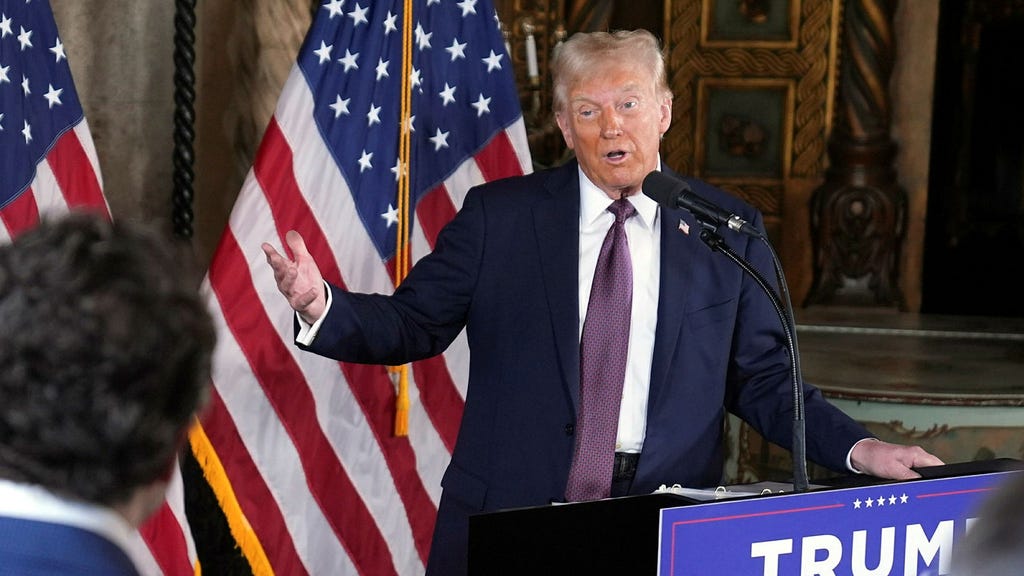This article from Dagens Nyheter, published on January 8, 2025, discusses the evolving nature of the Trump movement and its unexpected expansion of influence to Greenland. The headline provocatively declares that Trump, once perceived as a primarily domestic political force, is now ”showing his teeth” on the international stage, specifically in Greenland. This raises questions about the movement’s shift from an apparent inward focus to a more expansive, possibly nationalist, agenda. The article sets the scene by noting Trump’s performance at a Tuesday press conference, implying a connection between his statements or actions and the movement’s newfound interest in Greenland. The exact nature of this connection, however, remains unclear within the provided excerpt. The article’s central premise hinges on the contrast between the Trump movement’s previously perceived provincialism and its current international maneuverings. This shift is framed as a potential turning point, suggesting the movement’s earlier inward focus might be giving way to a more outward-looking, potentially aggressive posture. The mention of Greenland serves as a specific example of this evolving strategy, highlighting an unexpected and geographically significant target for the movement’s attention. The question posed – ”Can the earlier introversion be giving way to a more expansive nationalism?” – encapsulates the article’s core inquiry and sets the stage for further analysis.
The limited excerpt leaves many questions unanswered. What specific actions or statements by Trump during the Tuesday press conference prompted this analysis? How is the Trump movement manifesting its presence in Greenland? What are the implications of this apparent shift in focus for Greenland, the United States, and the broader international community? Is this a strategic move with specific geopolitical objectives, or a more opportunistic attempt to leverage influence in a new arena? The article’s incomplete nature necessitates speculation, leaving the reader to infer the author’s intended arguments and conclusions. The mention of a press conference suggests Trump’s direct involvement in the events unfolding in Greenland. This could involve policy pronouncements, diplomatic efforts, or even just rhetorical posturing aimed at garnering support or creating disruption. The use of the phrase ”showing teeth” further implies an aggressive or assertive stance, possibly indicating a challenge to existing power structures or a bid for greater influence in the region.
The choice of Greenland as the focal point is particularly intriguing. Greenland holds a unique geopolitical position due to its strategic location and its significant natural resources. Its relationship with Denmark adds another layer of complexity to the situation, potentially creating a point of friction between the Trump movement and established international alliances. The focus on Greenland also raises questions about the Trump movement’s broader international ambitions. Is this an isolated incident, or does it signal a more comprehensive strategy to expand influence beyond the United States’ traditional spheres of interest? The implications of such a strategy could be significant, potentially reshaping geopolitical dynamics and creating new alliances and rivalries.
The article’s brevity prevents a deeper understanding of the specific events unfolding in Greenland. However, it effectively raises several important questions about the evolving nature of the Trump movement and its potential impact on the international stage. The contrast between the movement’s perceived past insularity and its current international activism is a key theme, suggesting a significant shift in strategy. The focus on Greenland, a strategically important location, further underscores the potential geopolitical implications of this evolving agenda. The article’s open-ended nature encourages further investigation, leaving the reader to consider the broader implications of the Trump movement’s expansion onto the global stage.
To more fully understand the context of this Dagens Nyheter article, it is necessary to consider the historical backdrop of the Trump movement and its relationship with international affairs. During Trump’s presidency (2017-2021), his administration pursued a foreign policy often characterized by nationalism, protectionism, and a skepticism towards international institutions. This approach led to strained relationships with traditional allies and a re-evaluation of existing international agreements. While the article does not explicitly mention the specifics of Trump’s actions in Greenland, his past interest in acquiring the territory adds an important layer of context. In 2019, reports emerged that Trump had expressed interest in purchasing Greenland from Denmark, a proposal that was quickly dismissed by the Danish government. This historical context suggests that the Trump movement’s renewed interest in Greenland could represent a continuation of these earlier ambitions, potentially signaling a renewed push for influence in the Arctic region.
Furthermore, the article’s focus on the evolving nature of the Trump movement is crucial. Even after leaving office, Trump has maintained significant influence within the Republican Party and among his base of supporters. This continued influence raises questions about the long-term impact of his foreign policy approach, even beyond his own presidency. The article’s suggestion that the movement is becoming more ”expansive” in its nationalism suggests a potential shift from a primarily domestic focus to a more internationally assertive posture. This shift could have significant implications for future US foreign policy, regardless of who holds the presidency. The article’s framing of the situation in Greenland as the Trump movement ”showing its teeth” suggests a more aggressive or assertive approach to international affairs. This language implies a willingness to challenge existing norms and pursue a more confrontational stance on the global stage. The specific actions or statements that led to this characterization remain unclear, but the article’s tone suggests a significant escalation in the movement’s international engagement. Ultimately, the article’s focus on Greenland serves as a microcosm for the broader questions surrounding the Trump movement’s evolving international ambitions and its potential impact on global politics.














